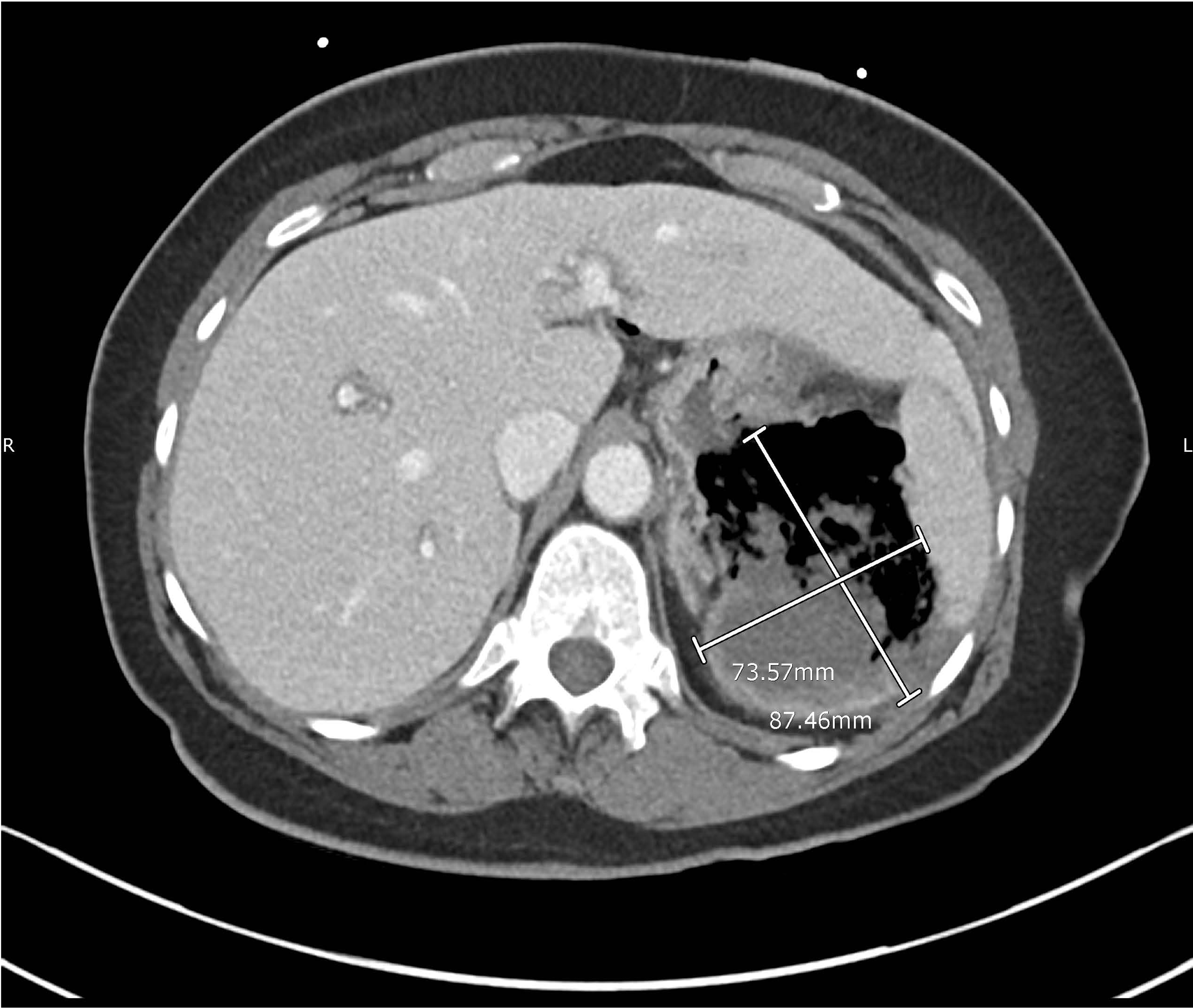Tuesday Poster Session
Category: Stomach
P5111 - Gastric Perforation: An Unexpected Case of DLBCL
Tuesday, October 29, 2024
10:30 AM - 4:00 PM ET
Location: Exhibit Hall E

Has Audio
- EB
Emma F. Basaran, MD
Naval Medical Center Portsmouth
Chesapeake, VA
Presenting Author(s)
Emma F. Basaran, MD1, Ashley Matias, MD2, Shira Paul, MD3
1Naval Medical Center Portsmouth, Chesapeake, VA; 2Naval Medical Center Portsmouth, Portsmouth, VA; 3Walter Reed National Military Medical Center, Portsmouth, VA
Introduction: Diffuse Large B Cell Lymphoma (DLBCL) is the most common subtype of Non-Hodgkin’s Lymphoma (NHL) and arises from mature B cells. Presenting symptoms are often due to mass effects from lymph node conglomerates or enlargement, however may also include "B symptoms". DLBCL can present as a mass anywhere in the body and be highly invasive requiring urgent intervention. We present an unusual case of DLBCL presenting as a gastric perforation.
Case Description/Methods: A 75-year-old woman presented to the Emergency Department for two weeks of left upper quadrant and left-sided, prandial chest pain, eventually accompanied by non-bloody, non-bilious emesis. The patient endorsed fevers, chills and a 14-pound weight loss over two months. Abdominal exam was consistent with peritonitis. Labs were notable for elevated lactate and leukocytosis. CT imaging revealed evidence of free air associated with a gastric perforation and a 9.3cm gastric mass that eroded into the spleen. The patient underwent emergent exploratory laparotomy and subsequent partial gastrectomy, splenectomy, and abdominal washings. Samples from the stomach, peritoneal washings, and esophagogastroduodenoscopy biopsy confirmed DLBCL. Further evaluation with a PET showed no additional sites of disease, consistent with stage IE DLBCL. The patient was treated with six cycles of R-CHOP, achieving a complete response.
Discussion: The differential diagnosis for gastric masses is extensive, ranging from primary gastric tumors, gastric adenocarcinomas, malignancies of the stomach wall and stromal tissue [including gastric lymphomas, gastrointestinal stromal tumors, leiomyomas, leiomyosarcomas, and neuroendocrine tumors], metastases, non-malignant etiologies such as endometriosis, and normal pancreas tissue. The gastrointestinal tract is the most common extranodal site of lymphoma with peak incidence at age 50 to 60 years. Presenting symptoms can include epigastric pain, weight loss from local compromise of gastrointestinal structures, anorexia, nausea, vomiting, and occult gastrointestinal bleeding; perforation is rare.
Diagnosis is made via lymph node or endoscopic biopsy. Histology and molecular testing are required for final diagnosis. Mainstay therapy is six cycles of chemotherapy with rituximab, cyclophosphamide, doxorubicin, vincristine, and prednisone (R-CHOP), with radiation if there is bulky disease. Surgery is reserved for cases of perforation, obstruction, or intractable bleeding and is not usually indicated as part of the treatment of DLBCL.

Disclosures:
Emma F. Basaran, MD1, Ashley Matias, MD2, Shira Paul, MD3. P5111 - Gastric Perforation: An Unexpected Case of DLBCL, ACG 2024 Annual Scientific Meeting Abstracts. Philadelphia, PA: American College of Gastroenterology.
1Naval Medical Center Portsmouth, Chesapeake, VA; 2Naval Medical Center Portsmouth, Portsmouth, VA; 3Walter Reed National Military Medical Center, Portsmouth, VA
Introduction: Diffuse Large B Cell Lymphoma (DLBCL) is the most common subtype of Non-Hodgkin’s Lymphoma (NHL) and arises from mature B cells. Presenting symptoms are often due to mass effects from lymph node conglomerates or enlargement, however may also include "B symptoms". DLBCL can present as a mass anywhere in the body and be highly invasive requiring urgent intervention. We present an unusual case of DLBCL presenting as a gastric perforation.
Case Description/Methods: A 75-year-old woman presented to the Emergency Department for two weeks of left upper quadrant and left-sided, prandial chest pain, eventually accompanied by non-bloody, non-bilious emesis. The patient endorsed fevers, chills and a 14-pound weight loss over two months. Abdominal exam was consistent with peritonitis. Labs were notable for elevated lactate and leukocytosis. CT imaging revealed evidence of free air associated with a gastric perforation and a 9.3cm gastric mass that eroded into the spleen. The patient underwent emergent exploratory laparotomy and subsequent partial gastrectomy, splenectomy, and abdominal washings. Samples from the stomach, peritoneal washings, and esophagogastroduodenoscopy biopsy confirmed DLBCL. Further evaluation with a PET showed no additional sites of disease, consistent with stage IE DLBCL. The patient was treated with six cycles of R-CHOP, achieving a complete response.
Discussion: The differential diagnosis for gastric masses is extensive, ranging from primary gastric tumors, gastric adenocarcinomas, malignancies of the stomach wall and stromal tissue [including gastric lymphomas, gastrointestinal stromal tumors, leiomyomas, leiomyosarcomas, and neuroendocrine tumors], metastases, non-malignant etiologies such as endometriosis, and normal pancreas tissue. The gastrointestinal tract is the most common extranodal site of lymphoma with peak incidence at age 50 to 60 years. Presenting symptoms can include epigastric pain, weight loss from local compromise of gastrointestinal structures, anorexia, nausea, vomiting, and occult gastrointestinal bleeding; perforation is rare.
Diagnosis is made via lymph node or endoscopic biopsy. Histology and molecular testing are required for final diagnosis. Mainstay therapy is six cycles of chemotherapy with rituximab, cyclophosphamide, doxorubicin, vincristine, and prednisone (R-CHOP), with radiation if there is bulky disease. Surgery is reserved for cases of perforation, obstruction, or intractable bleeding and is not usually indicated as part of the treatment of DLBCL.

Figure: CT imaging revealed evidence of free air associated with a gastric perforation and a 9.3cm gastric mass that eroded into the spleen
Disclosures:
Emma Basaran indicated no relevant financial relationships.
Ashley Matias indicated no relevant financial relationships.
Shira Paul indicated no relevant financial relationships.
Emma F. Basaran, MD1, Ashley Matias, MD2, Shira Paul, MD3. P5111 - Gastric Perforation: An Unexpected Case of DLBCL, ACG 2024 Annual Scientific Meeting Abstracts. Philadelphia, PA: American College of Gastroenterology.
